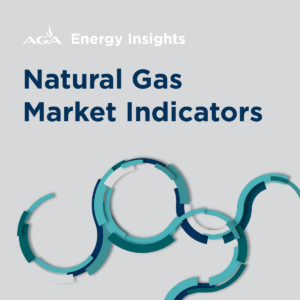Natural Gas Market Indicators – November 1, 2022
Updated on November 1, 2022
The price of natural gas is determined by numerous market factors such as supply and demand, weather, imports and exports, underground storage levels, and natural gas production.
With analysis from AGA’s Energy Markets and Analysis team, we are looking at recent market activity to better understand why the cost of natural gas is what it is today.
Market Summary
- The EIA natural gas weekly update reported an average of 99.1 Bcf per day dry gas production for the week ending October 26.
- The EIA reports the TTF price dropped below East Asia prices for the first time since April of this year early in the week ending October 26.
- EIA reports throughout the refill season (April – October) the average rate of injections into storage is 4% higher than the five-year average.
by the numbers
Market Statistics

3.5 Bcf per day
Demand is down 6.1 Bcf per day week over week but elevated 3.5 Bcf per day from the same time last year.

8 new plants
EIA reports eight new natural gas-fired combined cycle gas turbine power plants have or will come online by the end of 2022.

53% colder
End of shoulder season temperatures are 53 percent colder than last year and 17 percent colder than normal.
Weather
As of October 28, no named storms or cyclones are active in the Atlantic basin. As the shoulder season comes to an end, temperatures have been roughly 53 percent colder than last year, and 17 percent colder than normal. Excluding the Mountain and Pacific regions, all regions experienced colder temperatures than last year.
NOAA’s GFS ensemble model forecasted warmer temperatures across the country through the end of October, but predicts a cold front to push into the Northwest over the first week of November. The cold front is expected to make its way across the Midwest. NOAA expects temperatures in the East to remain relatively mild through the first two weeks of November.
Demand
Total demand reported by the EIA for week ending October 26 dropped to 92.5 Bcf per day as the weather during the tail end of shoulder season produces milder temperatures across the country. Demand is down 6.1 Bcf per day week over week but up 3.5 Bcf per day from the same time last year.
Natural gas for power generation slightly decreased from an average 31.0 Bcf per day from the prior report week to 29.3 Bcf per day for week ending October 26. These demands represent a significant departure from summer demands, and account for the bulk of the demand reduction in October.
EIA reports the residential and commercial sector having an average 3.6 Bcf per day drop in demand from 20.0 Bcf per day to 16.4 Bcf per day for the week ending October 26. Although a drop in demand week over week, the residential and commercial sector demand was still up from the average 14.7 Bcf per day for the same time last year.
Production
The Energy Information Administration’s Drilling Productivity Report published October 17 indicates an average daily growth of 79 Mmcf per day in production per region.
The Haynesville region showed the highest month-over-month increase in production with a 200 Mmcf per day increase from October into November, followed by the Permian with a 127 Mmcf per day increase. Despite those increases, the Appalachia region is expected to remain the highest producing region with an anticipated 89 Mmcf per day increase month over month to total 35.7 Bcf for the month of November.
The EIA natural gas weekly update reported an average 99.1 Bcf per day dry gas production for the week ending October 26, a 2.6 Bcf per day increase from the 96.5 Bcf per day average for the same time last year. This significant increase highlights the record-setting levels of natural gas production the US has seen over the shoulder season.
The increase in production is very welcome just as the EIA reports eight new natural gas-fired combined-cycle gas turbine power plants have come online or will come online in 2022, adding 7,775 MW of natural gas powered electricity to the electric grid. The addition of these plants is likely to increase pressure on natural gas supplies in the near future.
LNG Markets
The Natural Gas Weekly Update released by the EIA reported deliveries to LNG export terminals increased by 0.1 Bcf per day week over week to an average of 11.5 Bcf per day for the week ending October 26.
According to PointLogic, deliveries to South Louisiana and South Texas averaged 8.7 and 2.4 Bcf per day respectively. No gas was delivered to Cove Point, Maryland for the week ending October 26 due to ongoing planned annual maintenance.
Bloomberg Finance reported 22 LNG vessels with a combined carrying capacity of 81 Bcf departed the U.S. between October 20 and 26.
Notably, the EIA reports that over the last week of October the TTF price dropped below East Asia prices for the first time since the invasion of Ukraine. For the week ending October 26, Bloomberg reported weekly average futures for LNG cargoes in East Asia decreased $0.59 for a weekly average of $31.52 per MMBtu, while TTF LNG futures trading decreased $5.69 to a weekly average of $31.61 per MMBtu.
Pipeline Imports and Exports
EIA reported an average 0.6 Bcf per day decrease in imports from Canada for week ending October 26 as compared to the week prior. Following the decrease the total daily import average stands at 5.2 Bcf per day, a 0.5 Bcf per day decrease year over year. Exports to Mexico are also down from an average of 6.1 Bcf per day last week to 5.8 Bcf per day for the week ending October 26.
Underground Storage
The Energy Information Administration (EIA) reported that estimated working gas in storage was 3,394 Bcf for the week ending October 26, a net increase of 52 Bcf from the week prior. This net injection is 36 Bcf lower than the same week last year, and 14 Bcf lower than the 66 Bcf five-year (2017 – 2021) average. The 3,394 Bcf working gas stocks were 4 percent lower than the same time last year, and 5 percent lower than the five-year average. Although current stocks are estimated to be lower than last year, throughout the refill season (April – October) the average rate of injections into storage is 4% higher than the five-year average.
Rig Count
The U.S. rig count increased by two for a total of 771 for week ending October 21 with the addition of two oil-directed rigs. S&P global reported dry gas production for week ending October 24 remained in line with the previous report week.
Reported Prices
Henry Hub prompt month futures increased roughly $0.14 from $5.46 per MMBtu on October 19 to approximately $5.61 on October 25. Spot prices fell roughly $0.24 on October 19 from $5.50 to $5.26 per MMBtu on October 26, while the 12-month strip from November 2022 to October 2023 rose approximately $0.12 for an average of $5.30 per MMBtu. NYMEX contracts rose from $5.462 per MMBtu on October 19 to $5.60 per MMBtu on October 26, a $0.14 increase. Prices at the Waha Hub in Texas fell into the negatives earlier this week for the first time since October 2020, potentially due to limited takeaway capacity and mild weather.
For questions please contact Juan Alvarado | jalvarado@aga.org or Morgan Hoy | mhoy@aga.org
To be added to the distribution list for this report, please notify Lucy Castaneda-Land | lcastaneda-land@bmooreaga-org
NOTICE
In issuing and making this publication available, AGA is not undertaking to render professional or other services for or on behalf of any person or entity. Nor is AGA undertaking to perform any duty owed by any person or entity to someone else. Anyone using this document should rely on his or her own independent judgment or, as appropriate, seek the advice of a competent professional in determining the exercise of reasonable care in any given circumstances. The statements in this publication are for general information and represent an unaudited compilation of statistical information that could contain coding or processing errors. AGA makes no warranties, express or implied, nor representations about the accuracy of the information in the publication or its appropriateness for any given purpose or situation. This publication shall not be construed as including, advice, guidance, or recommendations to take, or not to take, any actions or decisions regarding any matter, including without limitation relating to investments or the purchase or sale of any securities, shares or other assets of any kind. Should you take any such action or decision; you do so at your own risk. Information on the topics covered by this publication may be available from other sources, which the user may wish to consult for additional views or information not covered by this publication.
